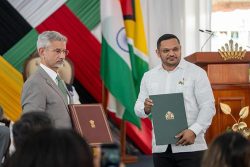Dear Editor,
President Irfaan Ali’s recent announcement that the three major bridges in Guyana—the existing Demerara Harbour Bridge, the new Demerara Harbour Bridge, and the future Berbice Bridge—will be free of charges is a bold and welcome move. This decision aligns with the government’s progressive social and economic campaign promises, aimed at easing the burden on everyday citizens and stimulating economic activity by making travel between key regions more accessible.
Currently, the Demerara Harbour Bridge sees an average of over 14,000 vehicles crossing daily, while the Berbice Bridge facilitates around 3,500 vehicles each day. By eliminating tolls, which range from GYD $200 for a car on the Demerara Bridge to as much as GYD $13,600 for larger vehicles on the Berbice Bridge, the government is providing significant financial relief to commuters and businesses alike. This could lead to increased economic activity as transportation costs decrease, benefiting both local commerce and the general public.
However, while this initiative is commendable, it also raises important questions about how the government plans to manage the associated costs, both now and in the future. The construction, maintenance, and eventual operation of these bridges, particularly the new Demerara Harbour Bridge, which is expected to cost around USD $260 million, and the Berbice Bridge still in the planning stages, are significant undertakings. With the elimination of tolls, the government will need to identify alternative revenue streams to fund these projects, which are critical to sustaining infrastructure quality and safety.
Given the present and future funding challenges—some known, others perhaps not yet on the horizon—the government must ensure that this policy doesn’t lead to financial strain or compromise the quality and safety of these infrastructures. Transparency in how these projects are financed and managed will be crucial in maintaining public trust. The government must clearly outline how it intends to cover the estimated annual maintenance costs, which could reach tens of millions of dollars.
This is an ambitious step forward, and with the right planning and execution, it could truly be transformative for Guyana. As we celebrate this move, it’s also important to keep an eye on the practicalities and ensure that the government has a clear, sustainable plan in place. Perhaps Guyanese will have to pay a special tax on gasoline to fund upkeep and maintenance of the country’s bridges.
Sincerely,
Keith Bernard




